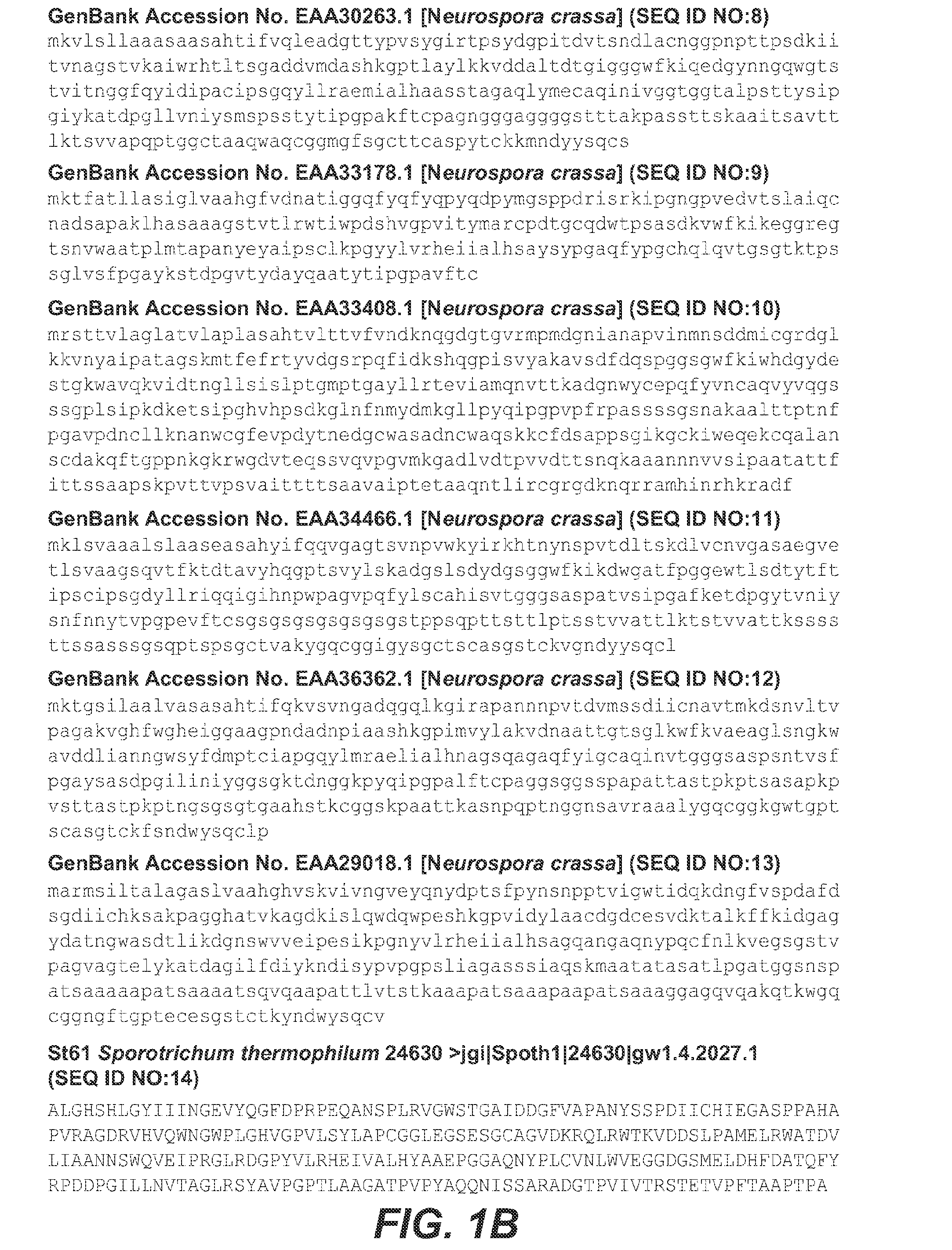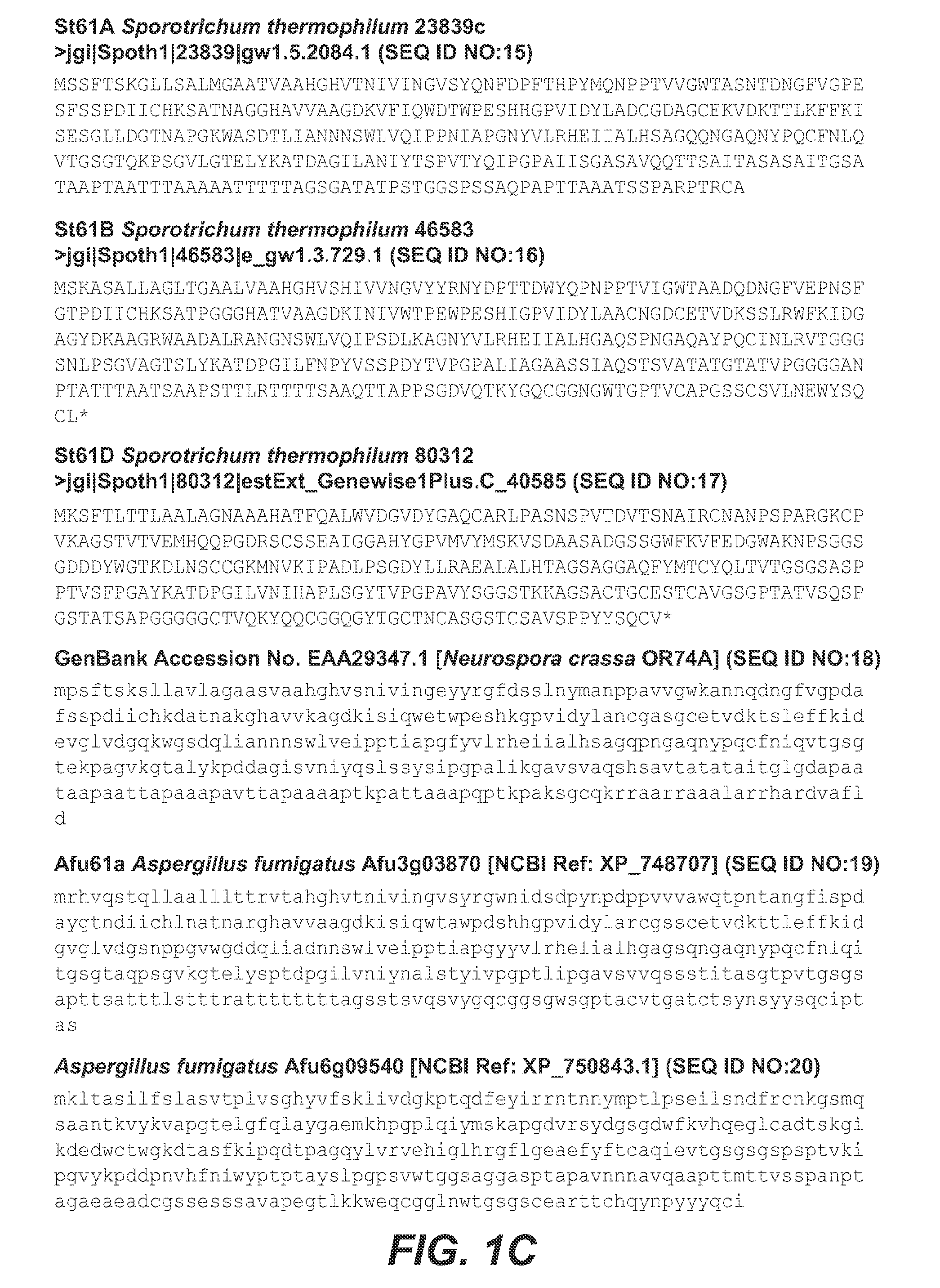Method for reducing viscosity in saccharification process
a technology of viscosity reduction and saccharification process, which is applied in the direction of hydrolases, biochemical apparatus and processes, enzymes, etc., can solve the problems of slow ethanol conversion research, inability to achieve efficient degradation of whole cellulase, and inability to achieve natural-occurring whole cellulase, etc., to achieve the yield of desirable fermentable sugars, reduce the viscosity of the mixture, and improve the yield of saccharification
- Summary
- Abstract
- Description
- Claims
- Application Information
AI Technical Summary
Benefits of technology
Problems solved by technology
Method used
Image
Examples
example 1
Assays / Methods
[0360]The following assays / methods were generally used in the Examples described below. Any deviations from the protocols provided below are indicated in specific Examples.
[0361]A. Pretreatment of Biomass Substrates
[0362]Corncob, corn stover and switch grass were pretreated prior to enzymatic hydrolysis according to the methods and processing ranges described in International Patent Publication WO06110901A (unless otherwise noted). These references for pretreatment are also included in the disclosures of US Patent Application Publications 20070031918-A1, 20070031919-A1, 20070031953-A1, and / or 20070037259-A1.
[0363]Ammonia fiber explosion treated (AFEX) corn stover was obtained from Michigan Biotechnology Institute International (MBI). The composition of the corn stover was determined by MBI (Teymouri, F et al. Applied Biochemistry and Biotechnology, 2004, 113:951-963) using the National Renewable Energy Laboratory (NREL) procedure, NREL LAP-002. NREL procedures are avai...
example 2
Construction of an Integrated Expression Strain of Trichoderma reesei
[0386]An integrated expression strain of Trichoderma reesei was constructed that co-expressed five genes: T. reesei β-glucosidase gene bgl1, T. reesei endoxylanase gene xyn3, F. verticillioides β-xylosidase gene fv3A, F. verticillioides β-xylosidase gene fv43D, and F. verticillioides α-arabinofuranosidase gene fv51A.
[0387]The construction of the expression cassettes for these different genes and the transformation of T. reesei are described below.
[0388]A. Construction of the β-Glucosidase Expression Vector
[0389]The N-terminal portion of the native T. reesei β-glucosidase gene bgl1 was codon optimized by DNA 2.0 (Menlo Park, USA). This synthesized portion comprised of the first 447 bases of the coding region. This fragment was PCR amplified using primers SK943 and SK941. The remaining region of the native bgl1 gene was PCR amplified from a genomic DNA sample extracted from T. reesei strain RL-P37 (Sheir-Neiss, G et...
example 3
Construction of T. reesei Strains
[0414]A. Construction of and Screening for T. Reesei Strain H3A / EG4#27
[0415]An expression cassette containing the T. reesei egl1 (also termed “Cel 7B”) promoter, T. reesei eg4 (also termed “TrEG4”, or “Cel 61A”) open reading frame, and cbh1 (Cel 7A) terminator sequence (FIG. 12A) from Trichoderma reesei, and sucA selectable marker (see, Boddy et al., Curr. Genet. 1993, 24:60-66) from Aspergillus niger was cloned into pCR Blunt II TOPO (Invitrogen) (FIG. 12B).
[0416]The expression cassette Pegl1-eg4-sucA was amplified by PCR with the primers:
(SEQ ID NO: 146)SK1298: 5′-GTAGTTATGCGCATGCTAGAC-3′(SEQ ID NO: 147)214: 5′-CCGGCTCAGTATCAACCACTAAGCACAT-3′
[0417]Pfu Ultra II (Stratagene) was used as the polymerase for the PCR reaction. The products of the PCR reaction were purified with the QIAquick PCR purification kit (Qiagen) as per the manufacturer's protocol. The products of the PCR reaction were then concentrated using a speed vac to 1-3 μg / μL. The T. reese...
PUM
| Property | Measurement | Unit |
|---|---|---|
| Temperature | aaaaa | aaaaa |
| Temperature | aaaaa | aaaaa |
| Fraction | aaaaa | aaaaa |
Abstract
Description
Claims
Application Information
 Login to View More
Login to View More - Generate Ideas
- Intellectual Property
- Life Sciences
- Materials
- Tech Scout
- Unparalleled Data Quality
- Higher Quality Content
- 60% Fewer Hallucinations
Browse by: Latest US Patents, China's latest patents, Technical Efficacy Thesaurus, Application Domain, Technology Topic, Popular Technical Reports.
© 2025 PatSnap. All rights reserved.Legal|Privacy policy|Modern Slavery Act Transparency Statement|Sitemap|About US| Contact US: help@patsnap.com



